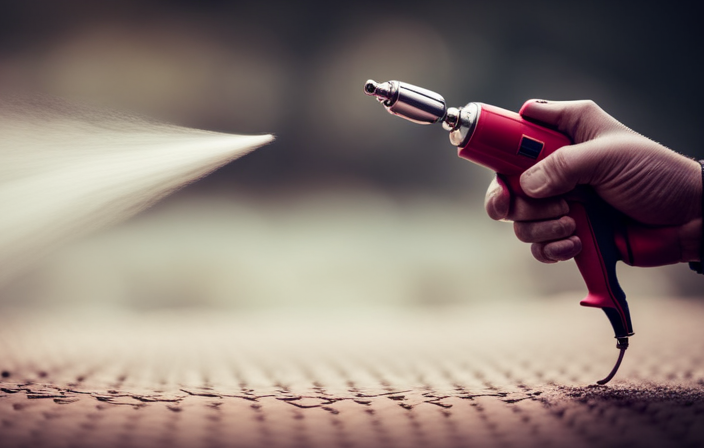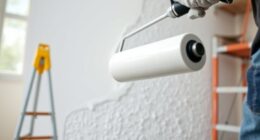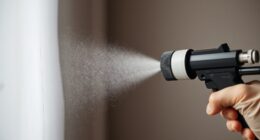To apply multiple coats efficiently, start with thorough surface prep, cleaning, and repairing imperfections. Use the right equipment, maintain steady pressure, and overlap passes by about 50% for even coverage. Apply each coat smoothly and at the correct distance, then allow ample drying and curing time before adding subsequent layers. Patience and proper technique help achieve a flawless finish that lasts. Keep exploring for detailed tips to perfect your spraying process.
Key Takeaways
- Ensure each coat is fully dry and cured before applying the next to promote proper bonding.
- Maintain consistent spray distance, pressure, and overlapping passes for even coverage.
- Prepare surfaces thoroughly, repairing imperfections and cleaning to enhance adhesion and finish quality.
- Apply coats in smooth, controlled strokes with proper technique to prevent streaks and uneven textures.
- Follow recommended drying times and environmental conditions to achieve a durable, professional finish.
Preparing Your Surface for Optimal Results
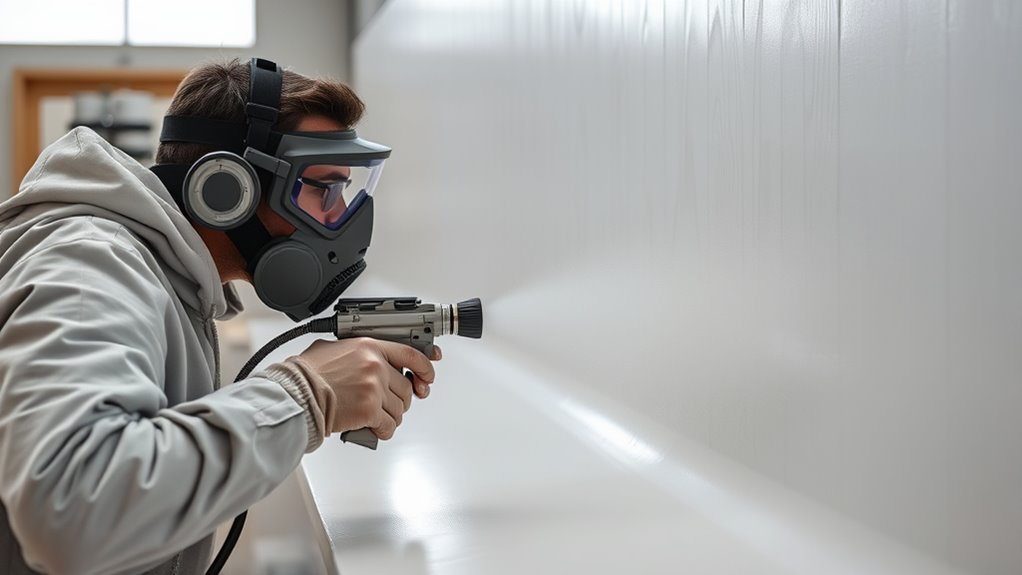
Before you begin spraying, it’s vital to prepare your surface thoroughly. Start with surface cleaning to remove dirt, grease, or debris that could hinder paint adhesion. Use a suitable cleaner and scrub the area well, ensuring a smooth, clean surface. Once dry, inspect for any imperfections, like cracks or holes, and repair them as needed. Proper surface cleaning creates a solid foundation for primer application, which is essential for achieving an even finish. Applying primer helps seal the surface, improves paint adhesion, and enhances durability. Make sure to choose the right primer for your material and follow the manufacturer’s instructions. Additionally, understanding the surface texture can help you select the appropriate spray technique for a uniform coat. Taking the time to prepare your surface properly ensures better coverage, reduces the need for touch-ups, and results in a professional-looking finish after your two coats.
Selecting the Right Equipment and Materials
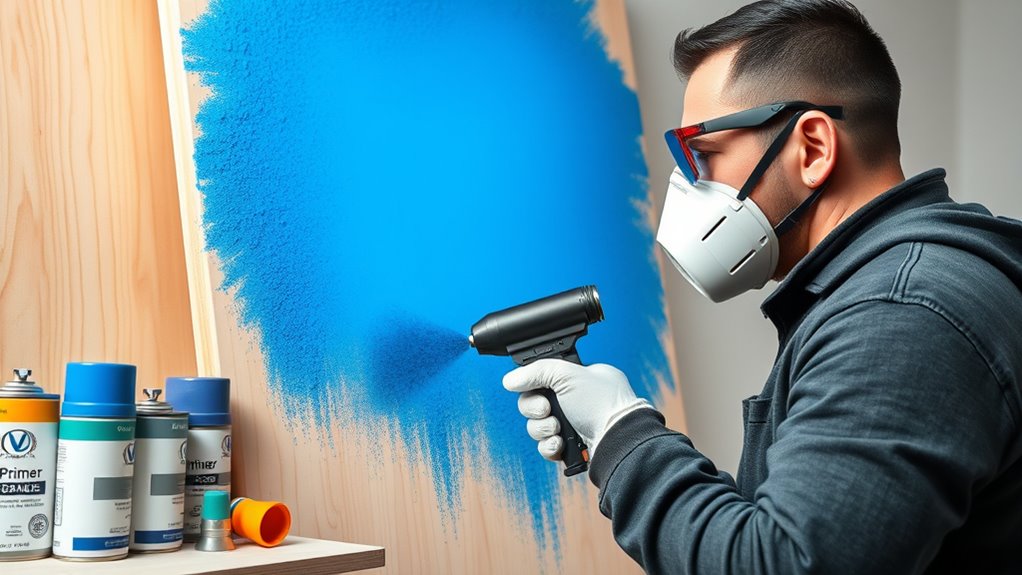
Choosing the right equipment and materials is essential for achieving a smooth, professional finish with your two-coat spray job. Start with primer selection to ensure proper adhesion and coverage; select a primer suited for your surface and paint type. When it comes to spray gun types, your options include HVLP, airless, or conventional spray guns. HVLP guns are ideal for fine finishes and minimal overspray, while airless sprayers cover large areas quickly. Consider the material viscosity and the desired spray pattern when choosing your equipment. Using the correct spray gun and primer will help you apply even coats, reduce waste, and achieve a consistent finish. Investing in quality tools and compatible materials sets a solid foundation for a successful two-coat spray project. Additionally, understanding how environmental factors and developmental stages can influence your work environment ensures optimal results and safety.
Proper Technique for Applying the First Coat
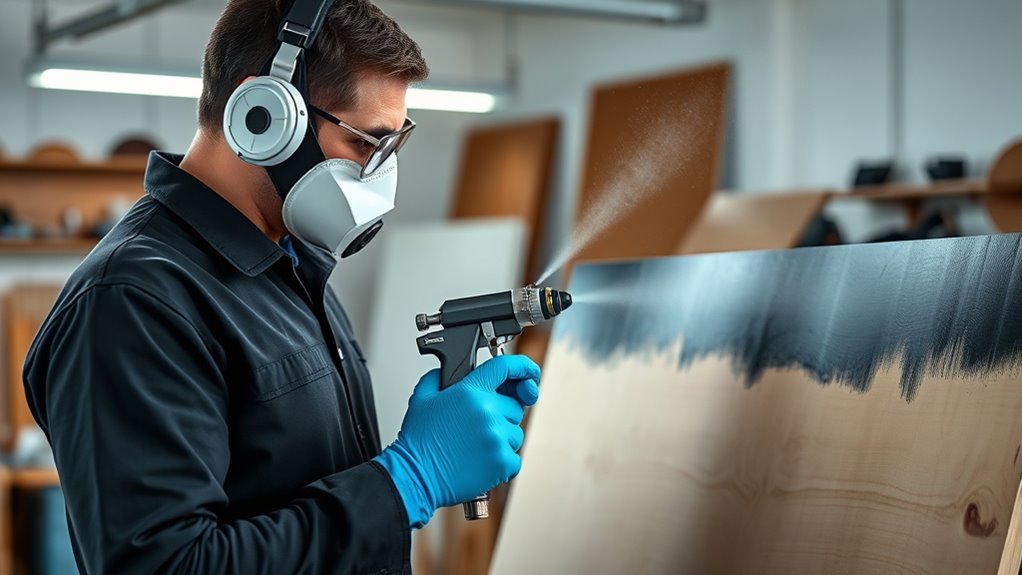
To achieve a smooth first coat, it’s crucial to maintain a consistent spray distance and motion throughout the application. Keep the spray pattern even, overlapping each pass by about 50% to avoid streaks or uneven coverage. Your brush techniques can also help, especially if you need to touch up or blend edges; use smooth, controlled strokes to ensure a seamless base. When spraying, hold the gun steadily and move steadily across the surface, avoiding pauses or sudden stops. Consistency in your spray pattern ensures even paint distribution and minimizes drips. Focus on maintaining a uniform distance—usually around 6-12 inches—and keep your motion steady. Proper technique at this stage sets a solid foundation for the subsequent coat, resulting in a professional finish.
Allowing Adequate Drying and Curing Time
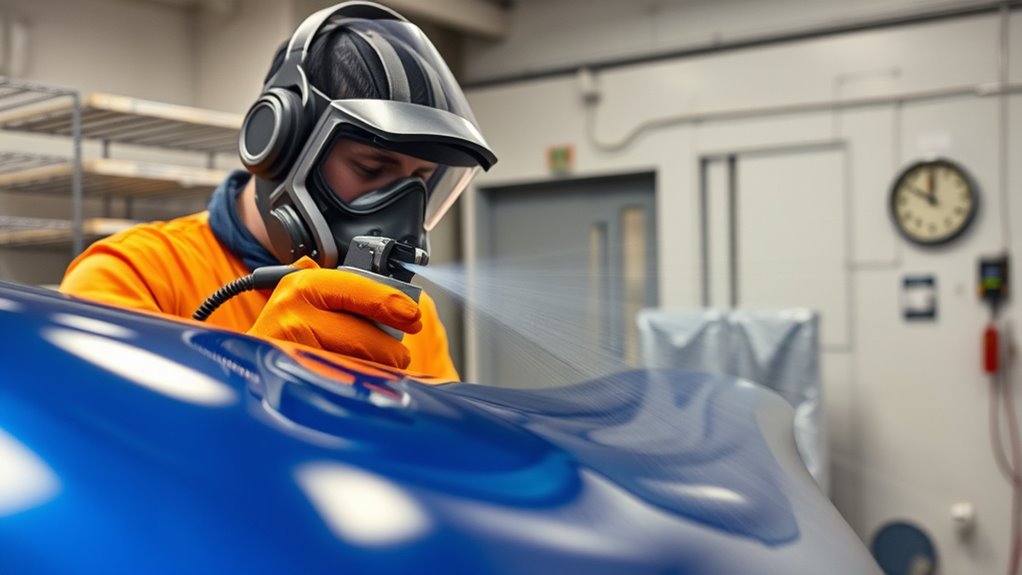
Allowing adequate drying and curing time is essential to achieve a durable and professional finish. Your drying environment plays a significant role; a well-ventilated, dust-free space ensures the coating dries evenly without imperfections. Follow the recommended curing schedule provided by the manufacturer, as rushing this process can compromise the coating’s adhesion and durability. Patience during this stage prevents issues like peeling or cracking later on. Avoid applying additional coats or handling the surface until the paint or primer has fully dried and cured. Proper timing guarantees the layers bond correctly, resulting in a smooth, long-lasting finish. Remember, rushing the drying process often leads to flaws that can be difficult to correct, so give your project the time it needs for ideal results. Additionally, understanding the importance of proper curing can help ensure the longevity of your work.
Applying the Second Coat for a Flawless Finish
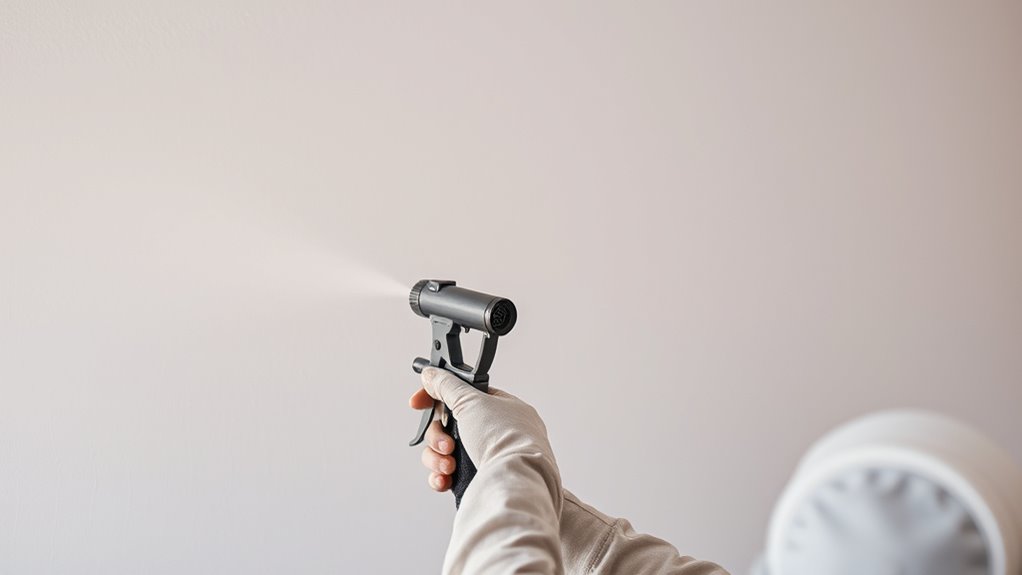
To achieve a flawless finish, you need to focus on proper drying techniques before applying the second coat. Make sure the first layer is fully dry and cured to prevent streaks or uneven texture. Use even application strategies to guarantee consistent coverage and a smooth, professional look. Additionally, ensuring proper filtration and pump protection can help maintain consistent spray quality and prevent issues during the application process.
Proper Drying Techniques
Ensuring proper drying between coats is essential for achieving a smooth, professional finish. You should monitor temperature control to prevent the paint from drying too quickly or too slowly, which can cause imperfections. Keep the environment well-ventilated and maintain consistent temperatures to promote even drying. Moisture management is equally important; too much humidity can extend drying time and lead to issues like bubbling or running. Use fans or dehumidifiers if necessary to control humidity levels. Avoid rushing the process, as applying a second coat too soon can trap solvents or moisture, resulting in a rough or uneven surface. By carefully managing temperature and moisture, you guarantee each layer dries correctly, setting the stage for a flawless, durable finish. Additionally, understanding celebrity transformations can inspire innovative approaches to achieving a polished look in your projects.
Even Application Strategies
Achieving a flawless finish with your second coat relies on applying it evenly and smoothly. To do this, focus on minimizing brush strokes, which can create uneven textures. Use a high-quality brush or roller, and work in long, consistent strokes to promote smooth color blending. Avoid overloading your brush, as excess paint can cause drips and uneven coverage. Maintain a steady pace and keep a wet edge to prevent lap marks. When blending, slightly overlap each pass to ensure seamless transitions between areas. Proper technique guarantees the second coat enhances the underlying layer, delivering a professional, uniform appearance. By paying attention to brush strokes and color blending, you’ll achieve a smooth, flawless finish that lasts. Understanding compatibility in application techniques can also help you adapt your approach for different surfaces and paints.
Tips for Achieving Consistent Coverage and Texture
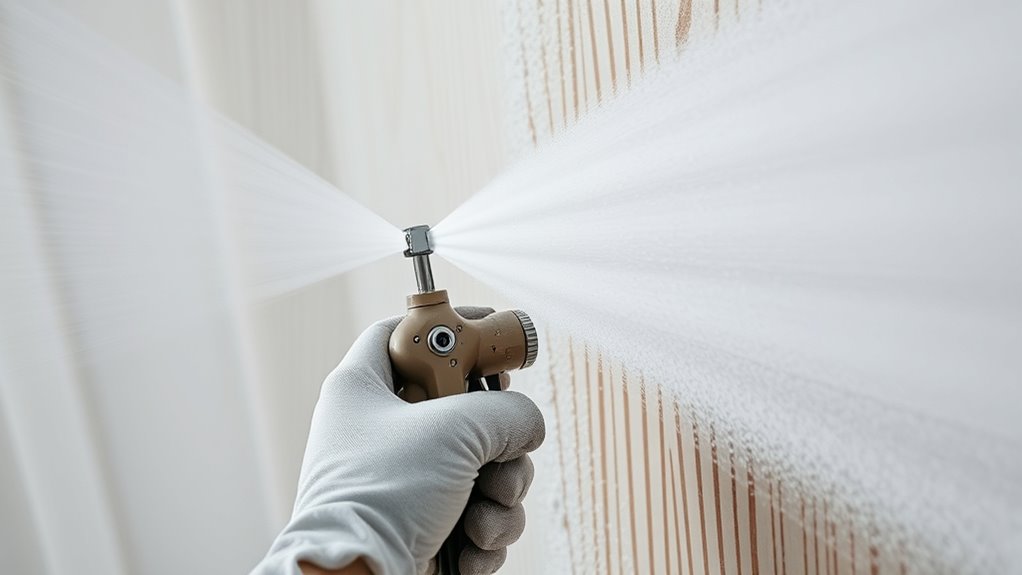
Getting consistent coverage and texture with your two-coat spray job requires attention to detail and proper technique. Start by using smooth, even brush techniques to blend edges and prevent streaks, especially when touching up or feathering paint. Focus on maintaining a steady hand and overlapping each pass slightly to guarantee uniform coverage. Color matching is vital; make sure your spray settings and materials are consistent between coats to avoid color discrepancies. Before applying the second layer, inspect your work for uneven spots or texture inconsistencies, and correct them promptly. Keep your spray gun at a consistent distance and motion to achieve a uniform finish. These steps help create a seamless appearance, ensuring your final result looks professional and polished.
Common Mistakes to Avoid During Two-Coat Spraying
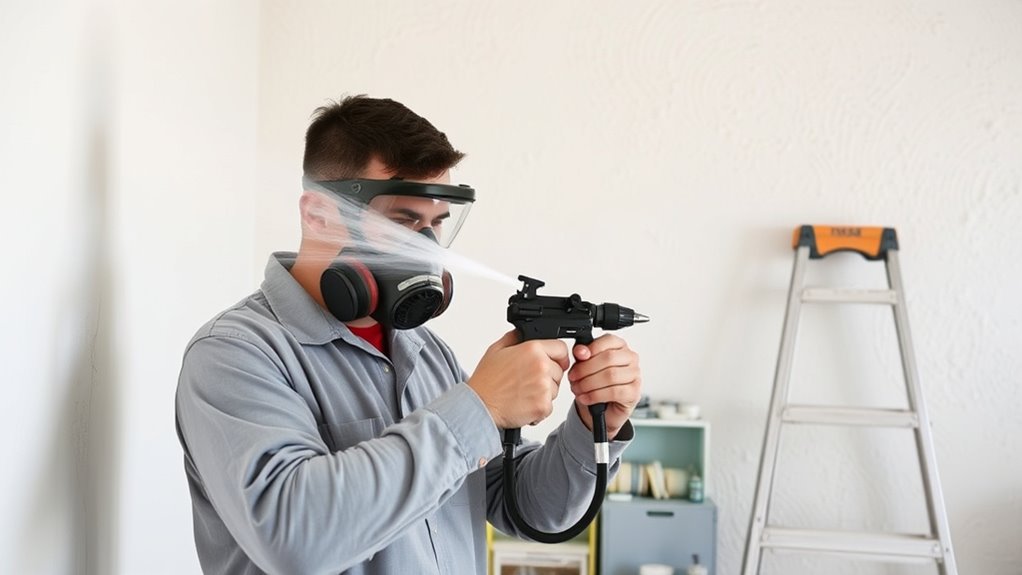
One of the biggest mistakes you can make is skipping proper surface preparation, which can cause uneven coverage. Applying coats too quickly or unevenly can lead to drips and inconsistent texture. Rushing drying times may result in smudges or peeling, so give each coat enough time to cure properly.
Ignoring Surface Preparation
Ignoring surface preparation is a common mistake that can profoundly compromise the quality of your two-coat spray job. If you skip cleaning or prepping the surface, issues like surface contamination and environmental factors can cause adhesion problems and uneven finishes. Before spraying, ensure the surface is free from dust, grease, and old paint. Failing to do so can lead to bubbles, peeling, or inconsistent coverage. Additionally, proper surface prep is crucial for achieving a smooth, professional finish and ensuring the durability of your work. Remember to:
- Clean thoroughly to remove dirt, oil, and debris
- Sand or prime surfaces as needed for smoothness
- Protect the area from dust and moisture during drying
Neglecting these steps can undermine your efforts and result in a less durable, professional-looking finish. Proper surface preparation is essential for a flawless, long-lasting coat.
Applying Uneven Coats
Applying uneven coats is a common mistake that can ruin the appearance and durability of your spray job. Uneven layers may cause mismatched colors and poor adhesion, especially if environmental factors like humidity or temperature fluctuate. To visualize, imagine this table:
| Area | Coating Thickness | Result |
|---|---|---|
| Left | Thin, uneven | Visible streaks, color mismatch |
| Center | Proper, even | Smooth, consistent finish |
| Right | Overly thick | Runs, drips, uneven drying |
To avoid this, maintain consistent spray distance and pressure, and monitor environmental conditions. Proper technique guarantees even coats, better color matching, and a professional finish. Don’t rush or skip these steps, as uneven coats can compromise your entire project. Consistent application techniques are essential for achieving a flawless result.
Rushing Drying Times
Rushing the drying process can undermine the quality of your two-coat spray job, even if the first coat looks good initially. Speeding curing or rushing application may seem efficient but often leads to issues like uneven finishes or peeling later. To avoid this, give each coat ample time to dry thoroughly before applying the next. Proper tuning options can also help optimize your vehicle’s performance and ensure the best results for your paint job.
Remember:
- Don’t skip drying times to save time, as it can cause adhesion problems.
- Check manufacturer instructions for recommended curing periods.
- Patience ensures your finish remains smooth and durable, preventing costly mistakes.
Taking the time to let coats dry properly helps you achieve a professional look and long-lasting results, avoiding the pitfalls of rushing application.
Frequently Asked Questions
Can I Apply More Than Two Coats for Better Durability?
You can apply more than two coats for better durability, but you need to ensure coating thickness and proper application techniques. Too many coats can lead to issues like cracking or uneven drying. Follow manufacturer guidelines for the recommended number of coats, and guarantee each layer dries thoroughly. Sticking to ideal coating thickness and using proper application techniques helps you achieve the desired durability without compromising the finish.
How Do Temperature and Humidity Affect the Spraying Process?
Sure, because controlling humidity impact and temperature is just a minor detail, right? In reality, high humidity can cause drips and uneven coats, while low humidity speeds up drying, risking cracks. Temperature control is essential; too hot, and the paint dries too fast, too cold, and it won’t set properly. Keep the environment steady, and your layers will spray on smoothly—without turning your project into a paint disaster.
Is It Necessary to Sand Between Coats?
You should sand between coats to guarantee proper surface preparation and paint compatibility. Sanding helps remove imperfections, roughen the surface, and promote better adhesion for the next layer. If you skip this step, the new coat may not bond well, leading to peeling or uneven finish. Always clean off dust after sanding to maintain a smooth, durable result. Properly preparing each layer guarantees a professional, long-lasting paint job.
What Are the Safety Precautions During Spraying?
When spraying, safety is key. You should always wear protective gear like masks, goggles, and gloves to shield yourself from fumes and overspray. Guarantee proper ventilation safety by working in well-ventilated areas or using exhaust fans, which helps disperse harmful vapors. Avoid inhaling fumes and minimize fire hazards. Always follow manufacturer instructions, and don’t rush—your safety depends on proper precautions during spraying.
How Do I Troubleshoot Uneven or Blotchy Coverage?
If you notice uneven or blotchy coverage, first check your spray technique—maintaining consistent distance and speed helps guarantee even paint application. Also, verify paint adhesion; poor surface prep can cause issues. Adjust your spray pressure if needed, and ensure you’re using the right nozzle. Sometimes, thinning the paint slightly improves flow. Properly troubleshooting these factors will lead to smoother, more uniform coats and better overall results.
Conclusion
Remember, applying two coats isn’t just about layers; it’s about creating a masterpiece like the Renaissance artists who built their works piece by piece. When you prep thoroughly, choose the right tools, and follow proper techniques, you’ll achieve a smooth, flawless finish. Patience is your greatest ally—think of it as laying the foundation for something that will stand the test of time. With care and attention, your project will truly shine.






